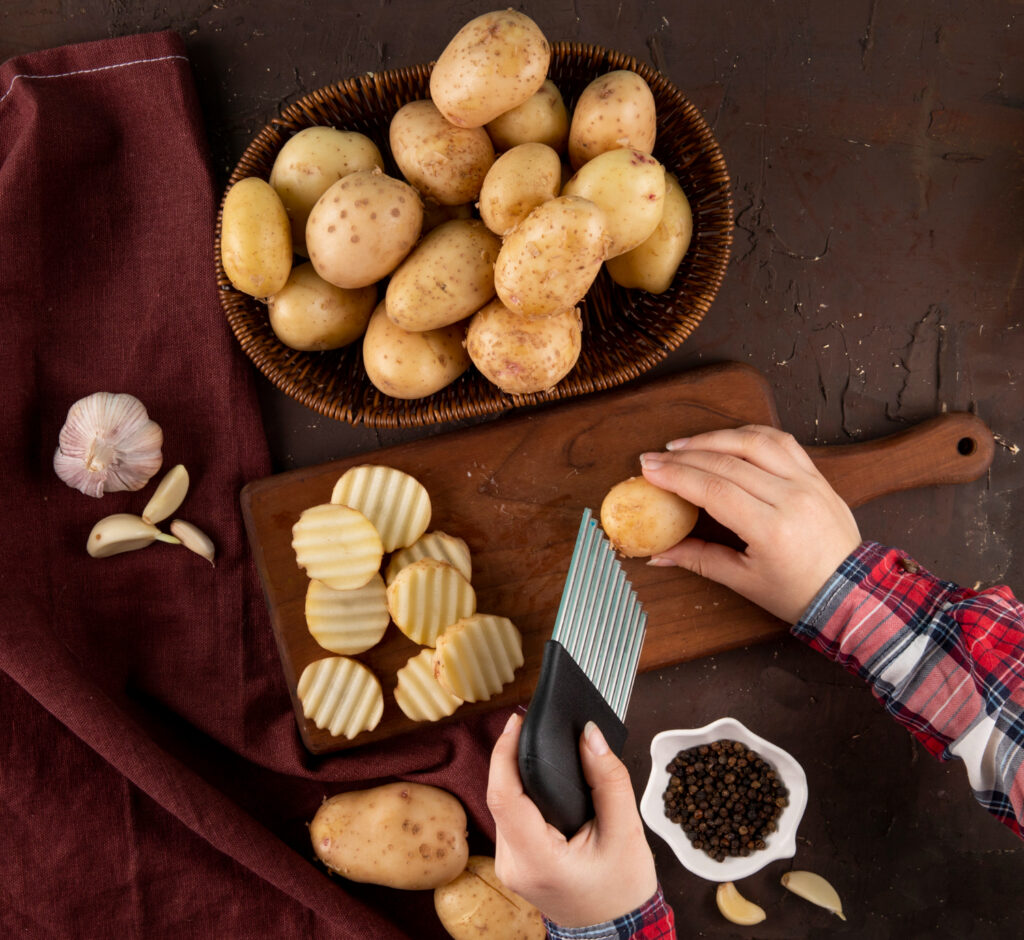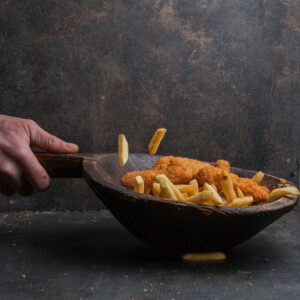Introduction:
Baking a potato is often touted as a simple kitchen task, but anyone who’s ended up with a soggy spud or a burnt offering knows that achieving potato perfection can sometimes feel like chasing a culinary mirage. Yet fear not, for within these virtual pages lies the key to unlocking the mysteries of how to bake a potato flawlessly every single time.
Picture this: a perfectly goldenbrown exterior giving way to a cloudlike, pillowy interior with just the right amount of seasoning. It’s the stuff of potato dreams, and with the right techniques at your fingertips, it’s entirely within your reach.
In this comprehensive guide, we’re not just scratching the surface. We’re diving deep into the heart of how to bake a potato to ensure that each and every tuber that emerges from your oven is a masterpiece in its own right. From selecting the finest spuds to mastering the baking process, consider this your roadmap to potato perfection.
Selecting the Perfect Potato:
When it comes to how to bake a potato, the journey begins long before the oven is even preheated. The foundation of a perfectly baked spud lies in selecting the right potato for the job. Let’s dive into the details:
1. Types of Potatoes: Not all potatoes are created equal, especially when it comes to baking. Three varieties stand out as top contenders: russet, Yukon Gold, and sweet potatoes. Russet potatoes, with their high starch content, yield a fluffy interior and crispy skin when baked. Yukon Gold potatoes offer a buttery texture and golden hue, while sweet potatoes bring a touch of sweetness to the table.
2. Tips for Choosing Quality Potatoes: Whether you’re perusing the aisles of your local grocery store or browsing the stalls at the farmer’s market, selecting the best potatoes is essential for achieving baking success. Look for potatoes that are firm to the touch, free from blemishes or sprouting eyes. Avoid potatoes that feel soft or have green patches, as these indicate age or exposure to light.
3. Importance of Size and Shape: Size matters when it comes to baking a potato. Larger potatoes will take longer to bake and may require adjustments to cooking times and temperatures. Aim for potatoes that are uniform in size to ensure even baking. Additionally, consider the shape of the potatoes; round or ovalshaped potatoes are ideal for baking, as they provide a consistent cooking surface and uniform texture.
Preparing Your Potatoes:
Before you can embark on the journey of how to bake a potato to perfection, it’s crucial to prepare your spuds with care. Let’s dive into the essential steps:
1. Washing and Scrubbing: Start by giving your potatoes a thorough wash under cold running water. Use a vegetable brush to scrub away any dirt or debris clinging to the skin. Remember, cleanliness is key to ensuring that your baked potatoes are not only delicious but also safe to eat.
2. To Pierce or Not to Pierce: One of the ageold debates in the world of potato baking is whether or not to pierce the potatoes with a fork before baking. While some swear by this practice to prevent potential explosions, others argue that it’s unnecessary. The truth lies somewhere in between. Piercing the potatoes allows steam to escape during baking, preventing them from bursting open. However, if you prefer your potatoes with a softer, creamier texture, you may opt to skip this step and embrace the risk of a few potato explosions.
3. Seasoning Options: Elevate the flavor of your baked potatoes by experimenting with different seasoning options. A drizzle of olive oil, a sprinkle of salt, and a dash of herbs like rosemary or thyme can add depth and complexity to your spuds. Get creative with your seasonings and don’t be afraid to try new flavor combinations. Just remember to season the potatoes before baking to ensure that the flavors are infused throughout.
By taking the time to properly prepare your potatoes, you’re setting the stage for a culinary masterpiece. With clean, seasoned spuds ready to go, you’re well on your way to mastering how to bake a potato like a seasoned pro.
Mastering the Baking Process:
Now that your potatoes are prepped and ready, it’s time to delve into the heart of the matter: mastering the baking process. Let’s break it down step by step:
1. Ideal Oven Temperature and Baking Duration: The key to perfectly baked potatoes lies in finding the right balance of temperature and time. For mediumsized potatoes, preheat your oven to 400°F (200°C) and bake for approximately 45 to 60 minutes. Larger potatoes may require slightly longer baking times, while smaller ones will cook more quickly. It’s essential to adjust the baking duration based on the size of your potatoes to ensure that they’re cooked through without becoming overdone.
2. Baking Techniques: When it comes to how to bake a potato, there are two main techniques to consider: baking directly on the oven rack or using a baking sheet. Baking directly on the oven rack allows for better air circulation, resulting in crispier skin. However, it can also lead to drips and messes in your oven. Using a baking sheet eliminates this risk but may result in slightly less crispy skin. Choose the method that best suits your preferences and tolerance for cleanup.
3. Achieving Crispy Skin: The holy grail of baked potatoes is achieving that perfect balance of crispy skin and fluffy interior. To achieve crispy skin without overcooking the interior, start by brushing the potatoes with olive oil and sprinkling them with salt before baking. This will help draw moisture to the surface of the skin, promoting crispiness. Additionally, be sure to space the potatoes evenly on the baking sheet or oven rack to allow for even cooking and airflow.
By mastering the baking process, you’re unlocking the secret to perfectly baked potatoes every time. With the right temperature, technique, and timing, you’ll soon be serving up spuds that are crispy on the outside, fluffy on the inside, and utterly irresistible.
Troubleshooting Common Issues:
Even the most seasoned chefs encounter bumps along the road to potato perfection. But fear not, for with a little knowhow, you can troubleshoot common issues like a pro. Let’s tackle these problems headon:
1. Addressing Undercooked or Overcooked Potatoes: Achieving the perfect balance of tenderness can be tricky when it comes to how to bake a potato. If your potatoes are undercooked, simply return them to the oven and continue baking until they’re forktender. On the other hand, if your potatoes are overcooked and mushy, consider repurposing them into mashed potatoes or potato soup to salvage their texture.
2. Rescuing Dry or Tough Potatoes: Dry, tough potatoes are a disappointment, but they’re not beyond redemption. To rescue potatoes that have become too dry or tough during baking, try slicing them open and adding a pat of butter or a drizzle of olive oil to moisten them up. Alternatively, mash the potatoes with a splash of milk or cream to restore their creaminess.
3. Solutions for Burst Open or Spotty Potatoes: Sometimes, despite our best efforts, potatoes can burst open or develop undesirable spots during baking. To prevent bursting, be sure to pierce the potatoes with a fork before baking to allow steam to escape. If your potatoes do burst open, simply scoop out the fluffy interior and serve it with toppings as a loaded baked potato. As for spotty potatoes, simply trim away any affected areas before serving.
By addressing common issues with confidence and creativity, you’ll be able to navigate the challenges of how to bake a potato like a seasoned pro. With a few simple tricks up your sleeve, you’ll turn any potato mishap into a delicious opportunity.
Serving Suggestions and Creative Toppings:
Congratulations! You’ve successfully baked the perfect potato, and now it’s time to take your culinary masterpiece to the next level with a selection of mouthwatering toppings. Let’s explore some classic favorites and innovative alternatives:
1. Classic Toppings: Elevate your baked potato with timeless classics like creamy butter, tangy sour cream, fresh chives, and crispy bacon bits. These triedandtrue toppings add a burst of flavor and richness that never fails to satisfy.
2. Healthier Alternatives: For those seeking lighter options, consider swapping traditional toppings for healthier alternatives. Greek yogurt makes a creamy and proteinrich substitute for sour cream, while salsa adds a zesty kick without the extra calories. Sliced avocado brings a creamy texture and hearthealthy fats to the table, while steamed vegetables offer a pop of color and nutrition.
3. Exploring Global Flavors: Expand your culinary horizons by experimenting with toppings inspired by different cuisines. Try topping your baked potato with guacamole and salsa for a taste of Mexico, or sprinkle it with feta cheese and olives for a Mediterranean twist. Get creative with spices and seasonings to customize your potato to suit your taste preferences.
Beyond Baked Potatoes: Creative Uses for Leftovers:
Congratulations on mastering the art of how to bake a potato! But what do you do with those leftover spuds once the initial feast is over? Fear not, for there are countless ways to repurpose and reinvent your baked potatoes into delicious new dishes. Let’s explore some creative ideas:
1. Ideas for Repurposing Leftover Baked Potatoes: Transform your leftover baked potatoes into exciting new creations like potato salad, hash browns, or mashed potatoes. Dice them up and toss them with mayo, mustard, and herbs for a refreshing potato salad. Alternatively, shred them and fry them up for crispy hash browns, or mash them with butter and milk for creamy mashed potatoes. The possibilities are endless!
2. Tips for Storing Leftover Baked Potatoes: Proper storage is essential for maintaining the freshness and flavor of your leftover baked potatoes. Store them in an airtight container in the refrigerator for up to three days. To prevent them from drying out, wrap them individually in foil or plastic wrap before refrigerating.
3. Freezing Techniques: If you find yourself with more leftover baked potatoes than you can eat in a few days, consider freezing them for future use. To freeze baked potatoes, allow them to cool completely, then wrap them tightly in plastic wrap or aluminum foil. Place them in a freezersafe bag or container and store them in the freezer for up to three months. When ready to use, simply thaw them in the refrigerator overnight before reheating.
Expert Tips for Consistent Success:
Now that you’ve embarked on your journey to mastering how to bake a potato, it’s time to glean wisdom from those who have paved the way before you. Let’s tap into the expertise of professional chefs and seasoned home cooks to elevate your potatobaking skills to new heights:
1. Advice from the Pros: Professional chefs and experienced home cooks alike offer invaluable insights into perfecting the art of potato baking. Pay attention to their tips on selecting the best potatoes, seasoning techniques, and baking methods. Whether it’s ensuring even sizing for consistent cooking or experimenting with different seasoning combinations, there’s always something new to learn from those who have honed their craft.
2. Experimenting with Variations: Don’t be afraid to think outside the box and experiment with variations on the classic baked potato. Twicebaked potatoes, with their creamy mashed interiors and crispy exteriors, offer a delightful twist on tradition. Meanwhile, Hasselback potatoes, thinly sliced and seasoned, showcase a visually stunning presentation that’s sure to impress your guests. Embrace these variations as opportunities to showcase your creativity and flair in the kitchen.
3. The Path to Perfection: Finally, remember that mastering how to bake a potato is a journey, not a destination. It takes practice, patience, and a willingness to learn from both successes and failures. Don’t be discouraged by the occasional mishap; instead, use it as an opportunity to refine your technique and strive for continuous improvement. With each batch of potatoes you bake, you’ll come one step closer to achieving potato perfection.
By heeding the advice of experts, embracing experimentation, and maintaining a steadfast commitment to improvement, you’ll unlock the secrets to consistent success in the realm of potato baking. So roll up your sleeves, preheat that oven, and let your culinary creativity soar as you embark on your quest for potato perfection!
Conclusion:
Congratulations! You’ve now unlocked the secrets to mastering how to bake a potato like a true culinary aficionado. But this isn’t just about following a set of instructions—it’s about embracing the artistry and science behind the humble spud. With the insights shared in this ultimate guide, you’re equipped with the knowledge and skills to elevate your potatobaking game to new heights.
From selecting the perfect potatoes to mastering the baking process and exploring creative toppings, you’ve delved deep into the world of potato perfection. Armed with this expertise, you’re poised to impress friends and family alike with your culinary prowess.
So, as you preheat that oven and reach for your favorite spuds, remember that each potato holds the promise of a delicious masterpiece. With each batch you bake, you’re not just following a recipe—you’re crafting a culinary experience that’s uniquely yours.
So go ahead, embrace the challenge, and let your creativity shine. With each perfectly baked potato, you’re not just nourishing your body, but also feeding your soul. So here’s to many more adventures in the kitchen and countless moments of potato perfection!




